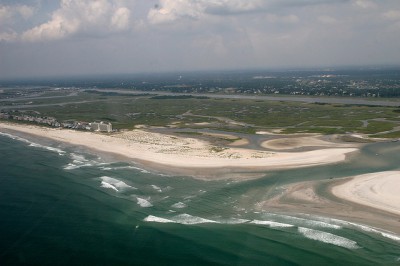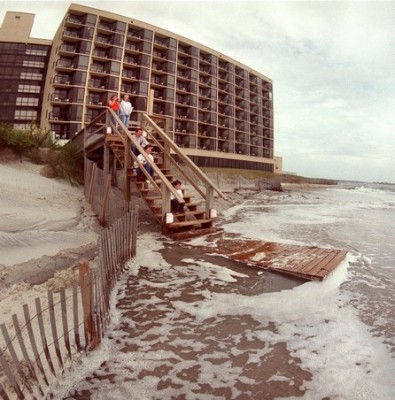
WILMINGTON — Property owners who agreed to pay for the relocation and subsequent maintenance of Mason Inlet have for years been asking New Hanover County to pick up some of the multi-million dollar tab.
The county has chipped in a little here and there since the inlet at Wrightsville Beach’s north end was moved nearly 3,000 feet northward more than a decade ago.
Supporter Spotlight
Now, thanks to a state law passed in the summer, the county may begin funneling money consistently toward the 30-year project, a move criticized by some who argue that a deal is a deal.
The bill, sponsored by Rep. Ted Davis, Jr., R-New Hanover, allows communities to dip into a portion of unused room occupancy tax collected in unincorporated areas of the county for shallow-draft inlet dredging.
An estimated $268,000 of the $1,072,000 pot initially would go toward paying for inlet maintenance costs if New Hanover County commissioners approve a deal initially borne out of the law passed in July, said Lisa Wurtzbacher, New Hanover County’s finance director.

The inlet was moved and the resort, top, is now out of danger.
A memorandum of understanding between county commissioners and the New Hanover County Tourism Development Authority directs 75 percent of the $1 million-plus to Carolina Beach Inlet maintenance. Mason Inlet will get the remaining 25 percent if approved by commissioners at their meeting tonight.
Supporter Spotlight
Money generated after the law was passed – about $150,000 annually and growing – will be split. Two-thirds of the cash generated from the tax will go toward tourism-related promotion, a bill-mandated rule.
“The other one-third would go to tourism activities, which we’ve defined as inlet maintenance,” Wurtzbacher said.
That remaining third would be divided 50/50 with about $25,000 going toward maintenance costs of each inlet.
“We’re trying to have this money spread out over a certain period of time,” Wurtzbacher said. “What we’ve done in the guidelines is make those funds last for five years. Mason Inlet is not being dredged every year. It’s supposed to occur on a three-year cycle.”
When Mason Inlet was relocated in 2002, a coalition of homeowner associations called the Mason Inlet Preservation Group representing 1,044 property owners at the north end of Wrightsville Beach and homeowners on adjacent Figure Eight Island made an agreement with the county to pay the bills for monitoring and maintenance through 2030.
The group has pushed for the county to tap its room occupancy tax to pay for some of the costs assessed to property owners, a move that historically has not gained the support of county and beach town leaders.
To date property owners who’ve benefited from the inlet relocation have been assessed more than $13.3 million, which includes relocation, maintenance and monitoring costs. New Hanover County has contributed a little more than $85,000 of the monitoring costs, Wurtzbacher said.
“The majority of the cost is still going to be borne by those property owners,” she said. “From a county perspective, while relocating that inlet is certainly a benefit to those property owners, the inlet is also an asset of the county as well.”
That’s the argument the preservation group has been making all along, said Frank Pinkston, the group’s former chairman.
“I think it’s appropriate that they pay for some of it out of that fund,” he said. “We did commit to reimbursing the county and we’ve been doing that. I always thought it was appropriate to help pay for that out of the bed tax fund. By moving that inlet we saved a big tax resource for the county.”
That’s beside the point, according to Mike Giles, a coastal advocate with the N.C. Coastal Federation.
“It’s not a lot of money but the thing is where does it stop?” he said. “Taxpayers should not be responsible. Whether it’s $12,000 or $120,000 it was an agreement and it’s legally binding in that permit.”
Doug Huggett, manager of the N.C. Division of Coastal Management’s Major Permits and Consistency Unit, said the source of funding for the project is not a requirement of the permit.
“We’re not quite as concerned about where the funding comes from,” he said. “If the funding mechanism changes, I don’t think that’s anything that has any kind of permit implication. From our perspective they are within the monitoring requirements.”
The state a couple of years ago agreed to drop its monitoring requirements for the inlet. The county is currently negotiating to change federal monitoring requirements.
Under the terms of the permit, issued in 2001 by the Army Corps of Engineers and coordinated by the U.S. Fish and Wildlife Service, the county is responsible for managing and monitoring migratory shorebirds on the north and south ends of Wrightsville Beach and the south end of Figure Eight Island.
The county was found last spring to be out of compliance with its federal permit after failing to adequately maintain shorebird habitat at the inlet, a job the county once contracted out to N.C. Audubon.
Corps’ officials determined in July that the county had addressed the issues.
The county earlier this year was granted permission by the federal agencies to cease monitoring, a stipulation the county has asked to be removed from the permit. In addition to dropping migratory shorebird monitoring requirements, the county has also asked to no longer monitor macroinvertebrate, such as clams and worms, and nix relocating the shorebird protection area in conjunction with erosion.
The county is still required to manage the area.







